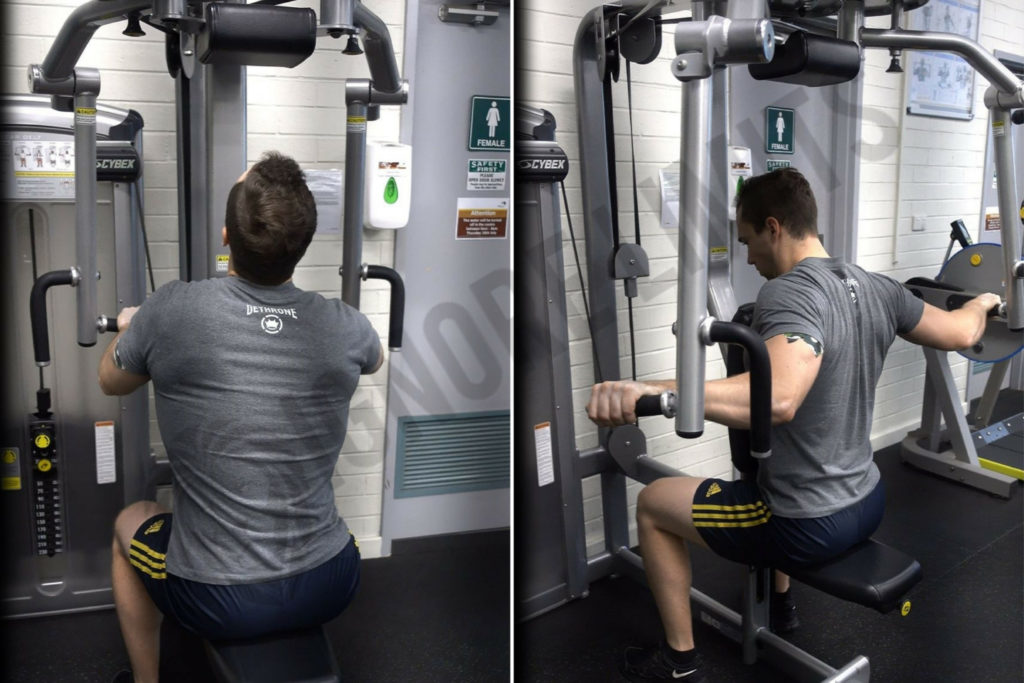Reverse Pec Deck Fly (Rear Delt Fly)
When training shoulders most guys neglect their rear deltoids! The anterior and medial deltoids receive all the love from presses and lateral raises, however the 'out of side, out of mind' mentality seems to come into play when it comes to the rear (posterior) deltoids!
The pec deck, utilizes an arcing movement to maintain tension on the rear delts.
Movement: Isolation
Targets: Shoulders
Required: Pec Deck Machine
Optional: N/A
Reverse Pec Deck Fly Form:
Sit on the pec deck fly machine with your stomach against the pad.
Grasp the pec deck handles ensuring your upper arms are parallel to the floor.
Push the handles back together as you contract your back and squeeze your shoulder blades.
Hold this contraction for 1 second.
Repeat for the desired number of repetitions.
Reverse Pec Deck Fly Variations
Unilateral Reverse Pec Deck Fly
Instead of contracting with two handles at a time you will push one handle while holding the other handle of the pec deck in a static hold, maintaining tension on that side of your deltoid between repetitions.
This is a fantastic core exercise and is often used for overcoming a lagging side/correcting dominance.
You'll find when flying one side at a time your core will need to be engaged the whole time to maintain your position on the machine.
Common Reverse Pec Deck Fly Mistakes
Not Hitting All Parts Of The Deltoid
Your shoulder is not just made up of one muscle, the shoulder is comprised of 3 ‘heads’, these are known as:
- The anterior deltoid (the front of your shoulder)
- The medial deltoid (the side of your shoulder)
- The posterior deltoid (the rear of your shoulder)
If you are not training all 3 heads you will not get round, full shoulders.
Shoulder training is based around 2 main movements, presses and raises, the traditional dumbbell and barbell presses are a great starting exercise for your shoulder routine as they are a compound exercise (and therefore hit all heads of the deltoid) we can then hone in on the anterior, medial and posterior heads individually through different variations of raises.
Using A Partial Range Of Motion
Partial reps can be used to push yourself beyond your point of failure at the end of your set, however strict, full range of motion must be practiced first.
Poor Scheduling Of Your Shoulder Workout
I highly recommend having at least 1 day between your chest and shoulder workouts.
The flat barbell bench press, incline bench press and dips place a large amount of tension on the front deltoids (even though the chest is the primary muscle targeted during this exercise).
If you’re going straight from a heavy chest workout on Monday into a shoulder workout on Tuesday you won’t be getting the best bang for your buck out of your workout – your shoulders will be recovering and from my experience you won’t be able to lift anywhere near as heavy as if they were fresh.
Ongoing, excessive amounts of stress placed on the shoulders can result in a shoulder impingement which’ll have you out of performing the vast majority of upper body exercises for weeks if not months, not good.
If you’re strapped for time and can only train three times a week the push/pull/legs workout regime is an option which hits both chest and shoulders in the same (push) workout however if you’re able to train 5 days a week I recommend performing a split in the following order:
Chest
Back
Shoulders
Arms
Legs
(rest)
Repeat
Alternatively, through a leg or rest day between your chest and shoulder workouts.
Similar & Substitute Exercises
- Cable Crossovers
- Flat Dumbbell Flies
- Incline Dumbbell Flies
